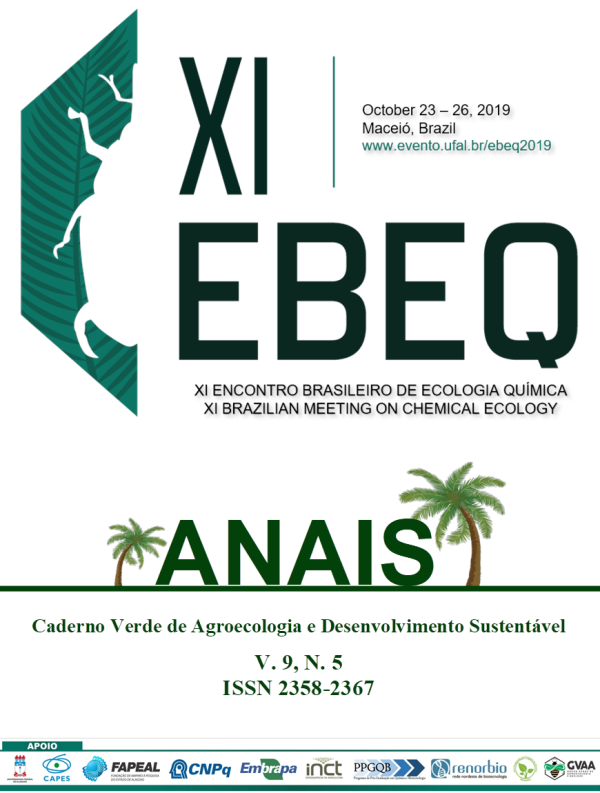SETTLEMENT PREFERENCE OF THE WHITEFLY Trialeurodes vaporarorium IN TOMATO PLANTS DAMAGED BY Tuta absoluta
Palavras-chave:
Trialeurodes vaporarorium, Tuta absoluta, TOMATO PLANTSResumo
Ecological relations (both, beneficial and detrimental) between insects and plants have been deeply studied One of the cues that insects can detect and use to find their host plants is the emission of volatiles by the plants. These emissions vary when plants are exposed to abiotic and biotic factors (for example, herbivory). In this work, the interaction between two main pests of tomato (Solanum lycopersicum, Solanaceae), Tuta absoluta (Lepidoptera: Gelechiidae) and Trialeurodes vaporariorum (Hemiptera: Aleyrodidae) was studied. Based on our own observations during field work of these two insects living together on the same plants (eventhough nearby uninfected plants were available), an assay (N = XX replicates) where tomato plants damaged by 3 rd -instar-T.absoluta-larvae (n = 20-25 larvae/plant) were offered paired to undamaged plants to T. vaporariorum was performed. After 72h, adults preferentially settled on T.absoluta-damaged plants (19 ± 5) over undamaged (9 ± 1, p = 0.036, Wilcoxon test). Volatiles from both kinds of plants (N =15 /each kind) were also collected (HayeSep-Q) and analyzed (damaged plants were produced in the same way as the one used in the assays). By GCMS, 88 compounds were quantified, and 46 were identified (comparing RI and % similarity with those reported in libraries). The volatile profiles of the plants in both physiological states differentiated (PLSDA, permutations test; p = 0.043). In this analysis, 31 compounds presented a Variable Importance in Projection score > 1 for component 1 and 26 compounds for component 2. The main compounds that contribute to this differentiation were up-regulated in damaged plants (βelemene,1: (70±10) ng equivalent of internal standard in healthy plants vs. (330±40) ng in damaged plants; Z-β-ocimeno,2 (29±8)ng vs. (330±30) ng and germacrene-D,3 (45±6)ng vs. (270±30) ng). These volatiles that differentiate damaged plants from healthy ones could be mediating the settling preference of T. vapororarium.Downloads
Publicado
Como Citar
Edição
Seção
Licença
Termo de cessão de direitos autorias
Esta é uma revista de acesso livre, em que, utiliza o termo de cessão seguindo a lei nº 9.610/1998, que altera, atualiza e consolida a legislação sobre direitos autorais no Brasil.
O(s) autor(es) doravante designado(s) CEDENTE, por meio desta, publica a OBRA no Caderno Verde de Agroecologia e Desenvolvimento Sustentável, representada pelo Grupo Verde de Agroecologia e Abelhas (GVAA), estabelecida na Rua Vicente Alves da Silva, 101, Bairro Petrópolis, Cidade de Pombal, Paraíba, Brasil. Caixa Postal 54 CEP 58840-000 doravante designada CESSIONÁRIA, nas condições descritas a seguir:
O CEDENTE declara que é (são) autor(es) e titular(es) da propriedade dos direitos autorais da OBRA submetida.
O CEDENTE declara que a OBRA não infringe direitos autorais e/ou outros direitos de propriedade de terceiros, que a divulgação de imagens (caso as mesmas existam) foi autorizada e que assume integral responsabilidade moral e/ou patrimonial, pelo seu conteúdo, perante terceiros.
O CEDENTE mantêm os direitos autorais e concedem à revista o direito de divulgação da OBRA, com o trabalho simultaneamente licenciado sob a Licença Creative Commons do tipo atribuição CC-BY.
O CEDENTE têm autorização para distribuição não-exclusiva da versão do trabalho publicada nesta revista.
O CEDENTE têm permissão e são estimulados a publicar e distribuir seu trabalho online (ex.: em repositórios institucionais ou na sua página pessoal) a qualquer ponto antes ou durante o processo editorial, já que isso pode gerar alterações produtivas, bem como aumentar o impacto e a citação do trabalho publicado.










